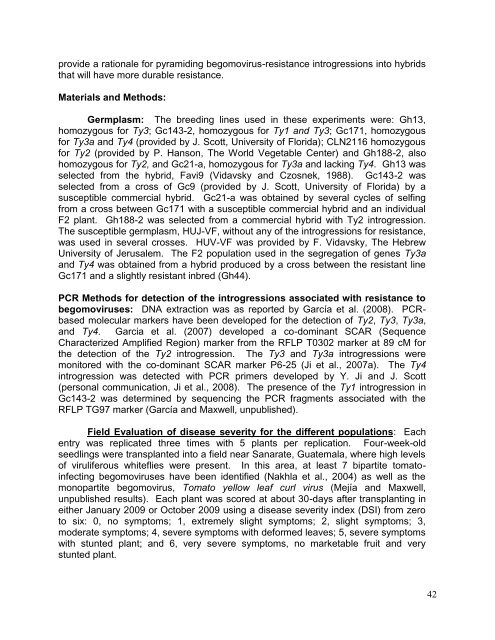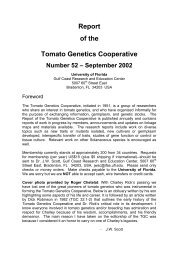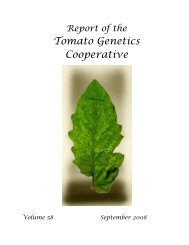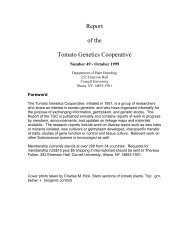Volume 60 - Tomato Genetics Cooperative - University of Florida
Volume 60 - Tomato Genetics Cooperative - University of Florida
Volume 60 - Tomato Genetics Cooperative - University of Florida
You also want an ePaper? Increase the reach of your titles
YUMPU automatically turns print PDFs into web optimized ePapers that Google loves.
provide a rationale for pyramiding begomovirus-resistance introgressions into hybrids<br />
that will have more durable resistance.<br />
Materials and Methods:<br />
Germplasm: The breeding lines used in these experiments were: Gh13,<br />
homozygous for Ty3; Gc143-2, homozygous for Ty1 and Ty3; Gc171, homozygous<br />
for Ty3a and Ty4 (provided by J. Scott, <strong>University</strong> <strong>of</strong> <strong>Florida</strong>); CLN2116 homozygous<br />
for Ty2 (provided by P. Hanson, The World Vegetable Center) and Gh188-2, also<br />
homozygous for Ty2, and Gc21-a, homozygous for Ty3a and lacking Ty4. Gh13 was<br />
selected from the hybrid, Favi9 (Vidavsky and Czosnek, 1988). Gc143-2 was<br />
selected from a cross <strong>of</strong> Gc9 (provided by J. Scott, <strong>University</strong> <strong>of</strong> <strong>Florida</strong>) by a<br />
susceptible commercial hybrid. Gc21-a was obtained by several cycles <strong>of</strong> selfing<br />
from a cross between Gc171 with a susceptible commercial hybrid and an individual<br />
F2 plant. Gh188-2 was selected from a commercial hybrid with Ty2 introgression.<br />
The susceptible germplasm, HUJ-VF, without any <strong>of</strong> the introgressions for resistance,<br />
was used in several crosses. HUV-VF was provided by F. Vidavsky, The Hebrew<br />
<strong>University</strong> <strong>of</strong> Jerusalem. The F2 population used in the segregation <strong>of</strong> genes Ty3a<br />
and Ty4 was obtained from a hybrid produced by a cross between the resistant line<br />
Gc171 and a slightly resistant inbred (Gh44).<br />
PCR Methods for detection <strong>of</strong> the introgressions associated with resistance to<br />
begomoviruses: DNA extraction was as reported by García et al. (2008). PCRbased<br />
molecular markers have been developed for the detection <strong>of</strong> Ty2, Ty3, Ty3a,<br />
and Ty4. Garcia et al. (2007) developed a co-dominant SCAR (Sequence<br />
Characterized Amplified Region) marker from the RFLP T0302 marker at 89 cM for<br />
the detection <strong>of</strong> the Ty2 introgression. The Ty3 and Ty3a introgressions were<br />
monitored with the co-dominant SCAR marker P6-25 (Ji et al., 2007a). The Ty4<br />
introgression was detected with PCR primers developed by Y. Ji and J. Scott<br />
(personal communication, Ji et al., 2008). The presence <strong>of</strong> the Ty1 introgression in<br />
Gc143-2 was determined by sequencing the PCR fragments associated with the<br />
RFLP TG97 marker (García and Maxwell, unpublished).<br />
Field Evaluation <strong>of</strong> disease severity for the different populations: Each<br />
entry was replicated three times with 5 plants per replication. Four-week-old<br />
seedlings were transplanted into a field near Sanarate, Guatemala, where high levels<br />
<strong>of</strong> viruliferous whiteflies were present. In this area, at least 7 bipartite tomatoinfecting<br />
begomoviruses have been identified (Nakhla et al., 2004) as well as the<br />
monopartite begomovirus, <strong>Tomato</strong> yellow leaf curl virus (Mejía and Maxwell,<br />
unpublished results). Each plant was scored at about 30-days after transplanting in<br />
either January 2009 or October 2009 using a disease severity index (DSI) from zero<br />
to six: 0, no symptoms; 1, extremely slight symptoms; 2, slight symptoms; 3,<br />
moderate symptoms; 4, severe symptoms with deformed leaves; 5, severe symptoms<br />
with stunted plant; and 6, very severe symptoms, no marketable fruit and very<br />
stunted plant.<br />
42





